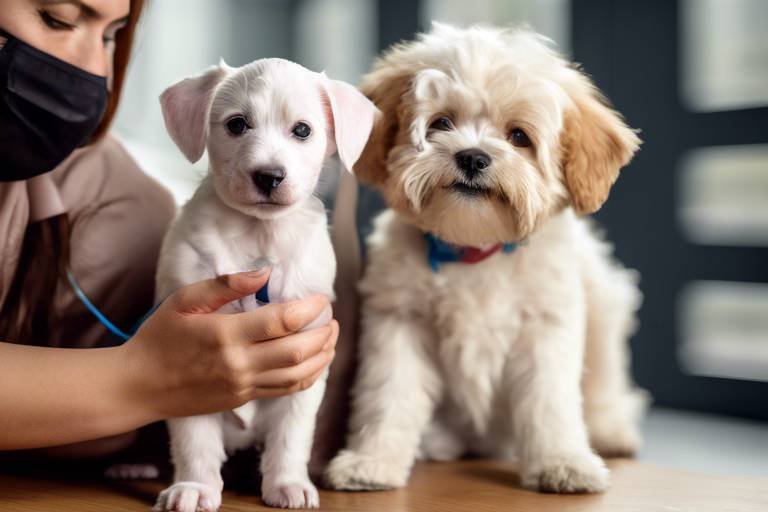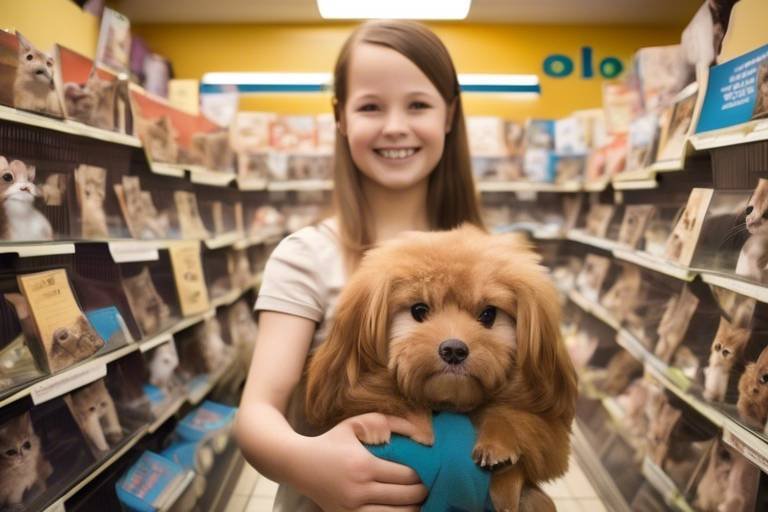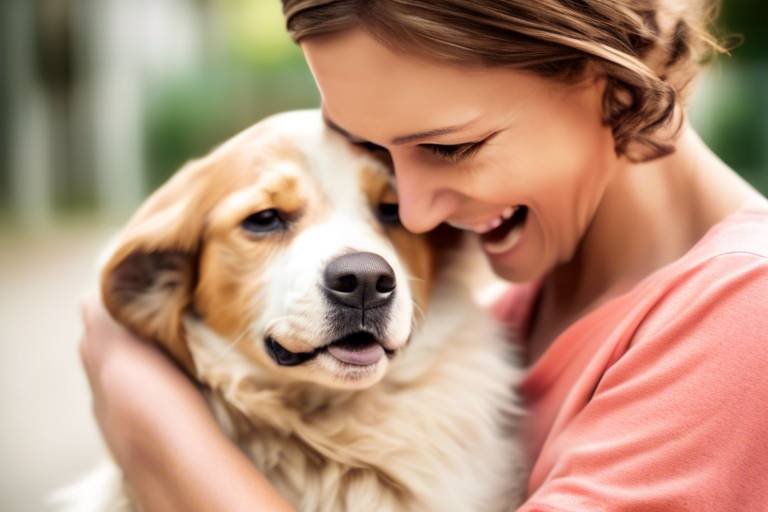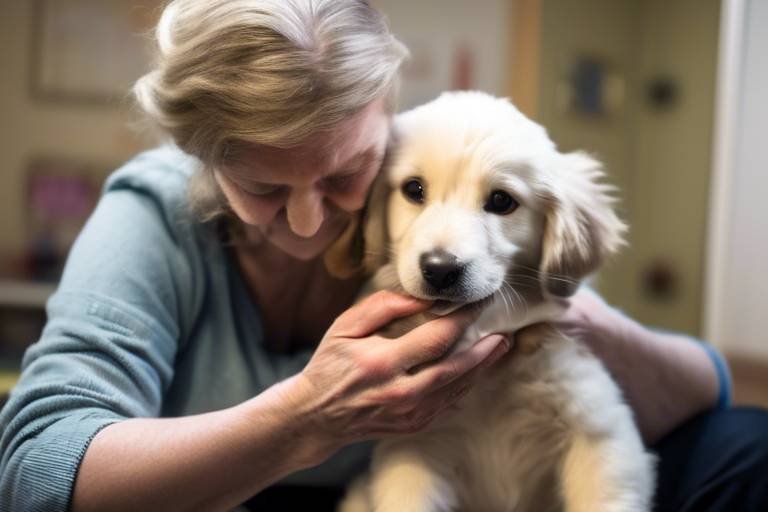How to Navigate Pet Adoption in a Pandemic
In these unprecedented times, the world has faced numerous challenges, and many people have turned to furry companions for comfort and companionship. If you're considering pet adoption during a pandemic, you're not alone! The thought of bringing a new pet into your home can be thrilling, but it also comes with its own set of challenges. So, how do you navigate the pet adoption process safely and effectively? In this article, we will guide you through the essential steps to ensure a smooth transition for both you and your future furry friend.
Adopting a pet during a pandemic can have profound emotional and mental health benefits. Pets offer unconditional love, companionship, and a sense of purpose, especially in these isolating times. Studies have shown that owning a pet can reduce feelings of loneliness and anxiety, making them the perfect addition to your household. As you consider pet adoption, think about how a pet could enrich your life and provide a comforting presence during tough times.
Choosing the right pet is crucial for a harmonious home. It's essential to consider various factors to ensure that your new companion fits seamlessly into your lifestyle. Ask yourself: What is your daily routine like? How much space do you have? What specific needs do different animals require? These questions will help you narrow down your options and find the perfect match.
Before diving into the adoption process, take a moment to evaluate your daily routine. Do you work long hours? Are you often busy on weekends? Understanding your schedule will help you determine how much time you can dedicate to a pet. Remember, pets thrive on attention and care, so make sure you can provide the love they deserve.
Owning a pet is not just a weekend project; it requires a long-term commitment. Daily tasks include feeding, exercising, grooming, and training your new friend. Consider creating a weekly schedule to visualize the time you'll need to invest. For example:
| Task | Frequency | Time Required |
|---|---|---|
| Feeding | Twice a day | 30 minutes |
| Walks | Daily | 1 hour |
| Grooming | Weekly | 1 hour |
| Training | Daily | 15 minutes |
Next, consider the physical space you have available in your home. Different pets have different space needs. For instance, dogs generally require more room to roam and play, while cats can thrive in smaller spaces. Ensure your living environment is suitable for your new pet's needs, providing them with a comfortable and safe area to call their own.
Each breed comes with its unique set of traits and behaviors. Before making a decision, take the time to research breeds that align with your lifestyle. For example, if you're a couch potato, a high-energy dog might not be the best fit. Understanding these characteristics can help you avoid potential challenges down the line and ensure a happy home for both you and your new companion.
The pandemic has transformed the way we approach pet adoption. Many shelters have adapted their processes to prioritize safety while still connecting pets with loving homes. From virtual meet-and-greets to safety protocols, navigating this new landscape can feel daunting, but it doesn't have to be!
One of the most exciting developments has been the rise of virtual adoption events. These online gatherings allow prospective pet owners to meet animals in need of homes from the comfort of their own living rooms. You can ask questions, view pets up for adoption, and even fill out applications—all while staying safe!
If you prefer to meet a pet in person, it's crucial to follow safety guidelines. Always wear a mask, maintain social distancing, and sanitize your hands before and after your visit. Many shelters have implemented strict protocols to ensure the safety of both visitors and staff, so be sure to check their guidelines before heading out.
Once you've chosen your new furry friend, it's time to prepare your home. Creating a welcoming environment is essential for your pet's transition. Start by gathering the necessary supplies to ensure they feel at home right away.
Here's a quick checklist of essential supplies you may need:
- Food and water bowls
- High-quality pet food
- Comfortable bedding
- Toys for playtime
- Grooming tools
- Health essentials (like a leash and collar for dogs)
Designate a specific area in your home where your new pet can feel secure during their transition. This space should be quiet and free from distractions, allowing them to acclimate to their new surroundings without feeling overwhelmed.
After adoption, it's essential to have access to resources that can help you and your new pet thrive. From finding a reliable veterinarian to locating training classes, being informed is key to a successful pet ownership experience.
Start by asking for recommendations from friends or family, or check online reviews. A good veterinarian will provide ongoing health care and support for your pet's needs, ensuring a long and healthy life together.
Training is crucial for your pet's well-being. It helps them learn basic commands and socialize with other animals and people. Look for local training classes or resources online to get started. Remember, a well-trained pet is a happy pet!
Once you've welcomed your new companion into your home, it's time to focus on building a strong bond. This relationship is built on patience, understanding, and love. Spend quality time together, engage in play, and learn about their unique behaviors.
Every pet has its personality, and understanding their behavior is crucial for a healthy relationship. Take time to observe your pet's actions and reactions, which will help you respond appropriately and strengthen your bond.
Consistency is key! Establishing routines for feeding, exercise, and playtime will help your new pet feel secure and loved. This structure not only benefits your pet but also makes your life easier as you adapt to pet parenthood.
Adopting a pet during a pandemic can be one of the most rewarding decisions you'll ever make. Not only will you provide a loving home to an animal in need, but you'll also gain a loyal companion who will brighten your days. So, take the leap and embrace the journey of pet parenthood—you won't regret it!
Q: How do I know if I'm ready to adopt a pet?
A: Consider your lifestyle, time commitment, and living situation. If you can provide a stable and loving environment, you're likely ready for pet adoption.
Q: What should I do if I encounter behavioral issues with my new pet?
A: Patience is key! Consider seeking advice from a veterinarian or a professional trainer who can provide guidance tailored to your pet's needs.
Q: Can I adopt a pet during a pandemic?
A: Absolutely! Many shelters have adapted their processes to allow for safe adoptions. Just be sure to follow safety guidelines if you visit in person.

The Importance of Pet Adoption
In times of uncertainty and isolation, the significance of pet adoption has never been more profound. Pets are not just adorable companions; they play a crucial role in enhancing our emotional and mental well-being. During a pandemic, when social interactions are limited, having a furry friend can provide a sense of comfort and companionship that many of us desperately need. Imagine coming home after a long day, and instead of silence, you’re greeted with wagging tails and soft purrs. It’s like having a little bundle of joy waiting just for you!
Research has shown that pet ownership can lead to numerous mental health benefits. For instance, pets can:
- Reduce Stress: Simply petting a dog or cat can lower cortisol levels, which are often referred to as the stress hormone.
- Combat Loneliness: A pet provides unwavering companionship, helping to alleviate feelings of loneliness during tough times.
- Encourage Physical Activity: Dogs, in particular, need regular walks, which can motivate their owners to get outside and exercise.
- Promote Routine and Structure: Caring for a pet requires a schedule, which can help create a sense of normalcy and routine in chaotic times.
Moreover, adopting a pet not only transforms your life but also saves another animal's life. Shelters are often overwhelmed, and by choosing to adopt, you’re giving a homeless animal a second chance at happiness. It’s a win-win situation! You gain a loyal friend, and they gain a loving home. This act of kindness can also inspire others in your community to consider adoption, creating a ripple effect of compassion.
In these unprecedented times, the importance of pet adoption extends beyond personal fulfillment. It contributes to the well-being of our communities. Pets can act as a bridge, connecting people and fostering new friendships among pet owners. Whether it’s chatting with neighbors during a walk or joining a local pet group, the bonds formed over shared love for animals can be incredibly rewarding.
Ultimately, pet adoption is not just about saving a life; it’s about enriching your own. The joy, laughter, and love that a pet brings into your home can be immeasurable. So, if you’re considering bringing a new furry friend into your life, know that you’re making a decision that can have a lasting impact on both you and your new companion.

Choosing the Right Pet for You
Choosing the right pet is one of the most crucial steps in the adoption process, especially during these unique times. You might be excited about the idea of having a furry friend at home, but it's essential to take a moment and reflect on what kind of pet will truly fit your lifestyle. After all, adopting a pet is not just about saving a life; it’s about ensuring a harmonious relationship that benefits both you and your new companion.
When considering which pet to adopt, think about your daily routine. Do you work long hours? Are you often on the go? Or do you have ample time to dedicate to a new friend? For instance, if you lead a busy life, a low-maintenance pet like a fish or a cat might be a better fit than a high-energy dog that requires daily walks and playtime. Conversely, if you’re home more often, a playful puppy or an active dog could be the perfect match.
Another significant factor to consider is the amount of space you have at home. Different pets have varying space requirements. For example, large dog breeds like Great Danes need more room to roam and play, while smaller breeds like Chihuahuas can thrive in smaller apartments. You might also want to think about whether you have a yard or nearby parks for outdoor activities. If you live in a small apartment, a small pet or a cat might be ideal.
Additionally, consider the specific needs of different animals. Some pets, like certain dog breeds, require more exercise and mental stimulation, while others might be content with a cozy corner and a few toys. The American Kennel Club provides valuable insights into various breeds, helping you understand their characteristics and care requirements. Researching breed traits can prevent future challenges and ensure you’re fully prepared for the commitment ahead.
To help you visualize the different factors to consider, here’s a simple table summarizing some common pets and their typical needs:
| Pet Type | Space Requirements | Time Commitment | Exercise Needs |
|---|---|---|---|
| Dog | Medium to Large | High | High |
| Cat | Small to Medium | Medium | Low |
| Fish | Small | Low | None |
| Hamster | Small | Low | None |
Ultimately, the goal is to find a pet that complements your lifestyle and brings joy to your life. Remember, adopting a pet is a long-term commitment, and you want to ensure that both you and your new companion are happy and fulfilled. So take your time, do your research, and trust your instincts. In the end, the right pet will not only enhance your life but will also become a beloved member of your family.
- How do I know if I'm ready for a pet? Assess your lifestyle, time, and financial commitment before adopting.
- What if I have allergies? Consider hypoallergenic breeds or smaller pets that may trigger fewer reactions.
- Can I adopt a pet if I work full-time? Yes, but consider pets that require less attention or look into pet-sitting options.
- How can I prepare my home for a new pet? Create a safe space, gather necessary supplies, and remove hazards.
Assessing Your Lifestyle
When it comes to bringing a new pet into your home, is crucial. You wouldn’t want to invite a boisterous puppy into a quiet home where everyone works long hours, right? Think about your daily routine and how a pet would fit into it. Ask yourself questions like: How much time do I spend at home? Am I often busy with work or social obligations? Do I have children or other pets that need attention? These questions will help you gauge not just your availability, but also your energy levels and the kind of environment you can provide.
Consider the following aspects of your lifestyle:
- Work Schedule: If you’re out of the house for long periods, a pet that requires less attention, like a cat, might be a better fit than a high-energy dog.
- Social Life: If you frequently entertain guests or travel, think about how a pet will adapt to those changes. Some pets thrive on social interaction, while others are more independent.
- Physical Activity: Are you an active person who enjoys outdoor activities? If so, a dog that enjoys long walks and playtime might be the perfect companion. Conversely, if you prefer a laid-back lifestyle, a more relaxed pet could be ideal.
It’s also essential to evaluate your financial situation. Pets come with expenses that go beyond just food and toys. Think about veterinary care, grooming, training, and unexpected health issues. A pet can be a wonderful addition to your life, but it’s important to ensure you can provide for their needs without stretching your budget too thin.
Another factor to consider is your living space. Do you live in a small apartment or a spacious house with a yard? Different pets have different space requirements. For example, a large dog will need room to roam, while a smaller animal like a hamster or a cat can thrive in tighter quarters. Make sure your home can accommodate the pet you’re considering, both in terms of space and a safe environment.
Lastly, think about your emotional readiness for a pet. Pets can bring immense joy, but they also require a commitment of love and care. Are you ready to handle the ups and downs of pet ownership? From playful antics to the occasional mess, a pet will become part of your family, and that comes with responsibilities. Taking the time to assess your lifestyle can lead to a more fulfilling and harmonious relationship with your new furry friend.
Time Commitment
When it comes to pet ownership, one of the most crucial aspects to consider is the involved. Bringing a new furry friend into your home is not just about the initial excitement; it’s about understanding that you are taking on a new responsibility that can last for many years. Just like a child, pets require consistent care, attention, and love. This means you need to evaluate your daily routine and determine how much time you can realistically dedicate to your new companion.
First off, think about your daily schedule. Do you work long hours? Are you frequently out of the house for social events or errands? If so, you may need to consider how you will manage your time to ensure your pet receives adequate attention and care. For instance, dogs typically need to be walked several times a day, while cats might require less frequent interaction but still need playtime and companionship. It’s essential to establish a routine that incorporates time for feeding, exercise, grooming, and training.
Here’s a breakdown of some typical time commitments you might need to consider:
- Feeding: Most pets require feeding at least twice a day, depending on their age and dietary needs.
- Exercise: Dogs, in particular, need regular walks and playtime. This could range from 30 minutes to several hours a day based on the breed and energy level.
- Grooming: Some pets need regular grooming sessions, which can take anywhere from 15 minutes to a couple of hours, depending on the breed.
- Training: Training sessions should be part of your routine, especially for puppies. Short daily training sessions of about 10-15 minutes can make a big difference.
In addition to daily tasks, don’t forget about the long-term commitments. Pets can live for many years, and their needs will evolve over time. For example, as pets age, they may require more frequent vet visits, special diets, or medications. Being prepared for these changes is essential to ensure that you can provide the best care possible.
Ultimately, the time commitment required for pet ownership is significant, but the rewards are immeasurable. The companionship, love, and joy that a pet can bring into your life are worth every minute you invest. So, take a moment to reflect on your lifestyle and ensure that you’re ready to embrace the time commitment that comes with welcoming a new pet into your home.
Q: How much time should I spend with my pet each day?
A: Ideally, you should spend at least a couple of hours each day interacting with your pet, including feeding, exercising, and playtime.
Q: What happens if I don’t have enough time for my pet?
A: Insufficient time can lead to behavioral issues, stress, and health problems for your pet. It’s crucial to assess your availability before adopting.
Q: Can I adopt a pet if I work full-time?
A: Yes, but you’ll need to ensure that you have a plan in place for exercise and companionship, such as hiring a dog walker or using pet daycare services.
Q: Are there pets that require less time and attention?
A: Yes, some pets, like certain cat breeds or small rodents, may require less time than dogs, but they still need care and interaction.
Space Requirements
When considering pet adoption, one of the most crucial aspects to evaluate is the for your potential furry friend. Different animals have varying needs when it comes to their living environment, and understanding these requirements can make all the difference in ensuring a happy and healthy home for your new companion. For instance, a large breed dog like a Great Dane will require significantly more space than a small breed dog like a Pomeranian. Similarly, cats need room to explore and play, but their space requirements may be less demanding compared to dogs.
Before you bring a pet into your home, take a moment to assess your living situation. Do you live in a spacious house with a yard, or are you in a cozy apartment? The size and layout of your home will influence the type of pet that is best suited for you. Here are some considerations to keep in mind:
- Indoor Space: Pets need room to move around, play, and rest. Larger pets will require larger spaces, while smaller pets can thrive in more compact areas.
- Outdoor Space: If you have a yard, consider how secure it is. Some pets, especially dogs, may need a fenced area to run and play safely.
- Activity Level: High-energy pets, such as certain dog breeds, may require more space to roam and play, while others may be more content with a cozy corner to curl up in.
To illustrate the differences in space requirements, consider the following table:
| Pet Type | Minimum Space Requirement | Ideal Space Requirement |
|---|---|---|
| Small Dog (e.g., Chihuahua) | 200 sq. ft. | 500 sq. ft. |
| Medium Dog (e.g., Beagle) | 500 sq. ft. | 1,000 sq. ft. |
| Large Dog (e.g., Labrador) | 1,000 sq. ft. | 2,000 sq. ft. |
| Cat | 200 sq. ft. | 400 sq. ft. |
| Rabbit | 30 sq. ft. | 100 sq. ft. |
Ultimately, the goal is to create an environment where your pet can thrive. If you’re in a smaller space, consider adopting a pet that is known to adapt well to apartment living, such as a cat or a smaller dog breed. Remember, it’s not just about having enough room; it’s also about providing a safe and stimulating environment that meets your pet's needs. By taking the time to assess your space and choose the right pet, you're setting the stage for a fulfilling and joyful companionship.
Q: How do I know if my home is suitable for a pet?
A: Assess your living space, considering both indoor and outdoor areas. Ensure you have enough room for the pet's activity needs and that your home is safe and secure.
Q: Can I adopt a pet if I live in a small apartment?
A: Yes, many pets, particularly smaller breeds or cats, can thrive in apartments. Just make sure to provide them with enough stimulation and exercise.
Q: What if I have children at home?
A: Choose a pet that is known for being good with children. Additionally, teach your kids how to interact gently and respectfully with the new pet.
Researching Breed Characteristics
When it comes to pet adoption, understanding breed characteristics is crucial for ensuring a harmonious match between you and your new furry friend. Each breed comes with its own unique traits, temperaments, and needs, which can significantly impact your lifestyle. For instance, some dogs are known for their high energy levels and require ample exercise, while others may be more laid-back and content with a short walk around the block. Similarly, cat breeds vary widely, with some being social butterflies and others preferring solitude. So, how do you navigate this sea of information to find the perfect pet for your household?
Start by identifying the key characteristics that matter most to you. Ask yourself questions such as:
- What is my activity level?
- How much time can I dedicate to training and socialization?
- Do I have any allergies to specific breeds?
- What is my living situation like—do I have a yard or live in an apartment?
Once you have a clear understanding of your preferences, dive into researching specific breeds. Online resources, breed-specific forums, and local shelters can provide valuable insights. Many shelters also offer information on mixed breeds, which can often combine the best traits of different breeds. For example, a Labrador Retriever mix might have the friendly nature of a Lab but the lower energy levels of another breed, making it a perfect fit for a busy family.
To make your research more effective, consider creating a comparison table to weigh the pros and cons of different breeds. Here’s a simple example:
| Breed | Energy Level | Size | Grooming Needs |
|---|---|---|---|
| Labrador Retriever | High | Large | Moderate |
| Bichon Frise | Low | Small | High |
| Beagle | Moderate | Medium | Low |
This table can help you visualize the differences between breeds and make an informed decision. Additionally, don't hesitate to reach out to pet owners or trainers for their firsthand experiences. They can provide insights that you might not find in books or online articles. Remember, adopting a pet is a long-term commitment, and understanding the breed characteristics can help you avoid potential challenges down the line.
Ultimately, the goal is to find a pet that not only fits into your lifestyle but also brings joy and companionship into your life. With the right research and preparation, you can ensure that your new pet will thrive in their forever home.

Adoption Process During COVID-19
Adopting a pet during the COVID-19 pandemic has transformed the way we connect with our furry friends. With social distancing measures in place, animal shelters and rescue organizations have had to adapt their processes to ensure the safety of both animals and potential adopters. This means that the traditional in-person visits and meet-and-greets have been replaced by innovative solutions that allow you to find your new companion from the comfort of your home.
One of the most significant changes is the rise of virtual adoption events. These online gatherings provide a platform for shelters to showcase their adoptable pets through live streams or pre-recorded videos. You can watch pets in action, hear their stories, and even interact with shelter staff to ask questions. This not only makes it easier to find a pet that resonates with you but also keeps everyone safe by minimizing physical contact. Imagine scrolling through a virtual pet fair, your heart racing as you see a playful puppy or a gentle cat that steals your breath away!
However, if you feel a strong connection with a pet and are ready to meet them in person, many shelters have implemented strict safety guidelines for in-person visits. When visiting a shelter, you may be required to wear a mask, maintain social distancing, and possibly schedule an appointment in advance. These measures help ensure that everyone involved remains healthy while still allowing you to interact with potential pets. It's like going on a first date, but with a furry friend instead of a human companion!
In addition, many organizations have adopted a foster-to-adopt model, where you can take a pet home temporarily to see if they fit well with your family. This approach not only allows you to assess compatibility in a real-world setting but also provides the pet with a loving environment while they await their forever home. It’s a win-win situation; you get to see if the pet is a good match, and the pet gets a break from the shelter environment.
As you navigate the adoption process, it’s crucial to stay informed about the specific procedures of the shelter or rescue organization you’re interested in. Many have updated their websites with detailed information on how to adopt during the pandemic, including forms you can fill out online and virtual meet-and-greet scheduling. Make sure to check these resources to ensure you’re prepared for your adoption journey.
In conclusion, while the adoption process during COVID-19 may look different, the opportunity to welcome a new pet into your home is just as rewarding. By embracing virtual events and adhering to safety guidelines, you can find your perfect companion and make a difference in their life. So, are you ready to take the leap and find your furry friend?
- What should I expect during a virtual adoption event? Virtual adoption events typically include live streams of pets available for adoption, where you can interact with shelter staff and ask questions about the animals.
- Are there any safety measures in place for in-person visits? Yes, most shelters require masks, social distancing, and may require appointments to ensure the safety of everyone involved.
- Can I take a pet home temporarily before deciding to adopt? Many shelters offer a foster-to-adopt program, allowing you to see how the pet adjusts to your home before making a long-term commitment.
Virtual Adoption Events
During these challenging times, have emerged as a game-changer for prospective pet owners. Imagine being able to browse through adorable pets from the comfort of your couch, all while sipping your favorite beverage! These online events not only provide a safe way to explore pet adoption but also offer a unique opportunity to connect with animals and their caretakers without the pressure of an in-person visit.
Most shelters and rescue organizations have quickly adapted to the circumstances by hosting live streams or video calls where you can see pets in real-time. It's like having a front-row seat to a pet showcase, complete with detailed descriptions of each animal's personality, needs, and quirks. You might even find yourself laughing at their silly antics as they play with toys or interact with their caretakers!
Here are some key features of virtual adoption events that make them appealing:
- Convenience: No need to travel to a shelter; you can participate from anywhere with an internet connection.
- Safety: Virtual events eliminate health risks associated with crowded spaces, ensuring the safety of both pets and potential adopters.
- Informed Decisions: With detailed information provided during the event, you can make a more informed choice about which pet might be the best fit for your home.
Some organizations even offer virtual meet-and-greets where you can interact with the pet you’re interested in adopting. This allows you to gauge their personality and see if there's a spark of connection before you commit to bringing them home. Plus, many shelters have dedicated staff available during these events to answer your questions and provide guidance on the adoption process.
As you participate in these events, keep in mind that while they are a fantastic way to find a new furry friend, it’s important to continue your research and follow up with the shelter or rescue organization afterward. Ask about the pet's health history, behavioral traits, and any special needs they may have. This ensures that you are fully prepared for the responsibility of pet ownership.
In summary, virtual adoption events are a brilliant way to connect with pets in need of homes while prioritizing health and safety. They open up new avenues for pet adoption, allowing you to find your perfect companion without leaving your home. So, grab your laptop, log in, and get ready to meet your future furry friend!
Q: How do I find virtual adoption events?
A: Many local shelters and rescue organizations promote their virtual events on social media platforms, their websites, or via email newsletters. Sign up for updates to stay informed!
Q: Can I adopt a pet directly from a virtual event?
A: Yes! Many organizations allow you to fill out an adoption application during or after the event. Make sure to ask about the specific process for the pet you’re interested in.
Q: What if I want to meet the pet in person before adopting?
A: Most shelters will arrange a safe, in-person meeting after a successful virtual introduction. This way, you can ensure that the pet is a good fit for your home before making a final decision.
Safety Guidelines for In-Person Visits
When it comes to adopting a pet during a pandemic, ensuring the safety of both yourself and the animals is paramount. As you prepare for in-person visits to shelters or foster homes, there are several essential safety guidelines to keep in mind. First and foremost, always wear a mask and maintain a safe distance from others. This not only protects you but also helps keep the shelter staff and other visitors safe. Remember, a little precaution goes a long way!
Before you head out, it’s a good idea to check the shelter's website or call ahead to understand their specific protocols. Many shelters have implemented appointment-only visits to limit the number of people on-site at any given time. This helps create a more controlled environment, reducing the risk of exposure. When you arrive, follow any posted signs and directions from staff to ensure everyone adheres to safety measures.
During your visit, try to keep your interactions brief and focused. While it’s tempting to spend time with every adorable face you see, remember that the goal is to find the right match for your home. Limit touching surfaces and objects as much as possible, and if you do, use hand sanitizer frequently. Many shelters provide sanitizing stations for your convenience.
Here’s a quick checklist of safety measures to consider:
- Wear a mask at all times.
- Practice social distancing of at least 6 feet.
- Limit your visit to one or two pets to ensure a focused approach.
- Use hand sanitizer before and after interacting with pets.
- Follow any specific protocols set by the shelter.
Finally, don't forget to ask questions! The shelter staff are there to help you find the perfect pet, and they can provide valuable insights into the animals' behaviors and needs. By adhering to these safety guidelines, you can make your in-person visit a positive experience for both you and the pets waiting for a loving home.
Q: What should I bring to my in-person visit?
A: It's best to bring a valid ID, any necessary paperwork (if applicable), and a list of questions you have about the pets you're interested in. Also, consider bringing a leash or carrier if you're planning to adopt on the spot.
Q: Can I bring my children or other pets to the shelter?
A: Many shelters recommend leaving other pets at home to avoid stress for the animals. As for children, check the shelter's policy regarding visitors; some may have age restrictions to ensure a calm environment.
Q: What if I feel unwell on the day of my visit?
A: If you're feeling unwell, it's best to reschedule your visit. Shelters appreciate your consideration for the health of their staff and animals.

Preparing Your Home for a New Pet
Bringing a new pet into your home is like welcoming a new family member. It’s an exciting time filled with joy and anticipation, but it also requires some serious preparation. Just like you wouldn’t invite a guest over without tidying up, you need to ensure your home is ready for your new furry friend. This means creating a safe, welcoming environment that caters to their needs and helps them adjust comfortably.
First and foremost, you’ll want to gather essential supplies. Think about what your new pet will need to thrive. This includes items like food and water bowls, appropriate food, a cozy bed, toys to keep them entertained, and grooming supplies. For example, if you’re adopting a dog, you might want to invest in a sturdy leash and collar, while a cat would need a litter box and scratching post. Here’s a quick checklist of essentials:
- Food and Water Bowls
- Pet Food
- Bedding
- Toys
- Grooming Supplies
- Litter Box (for cats)
- Leash and Collar (for dogs)
Next, consider the layout of your home. You need to create a safe space where your pet can feel secure. This may involve designating an area in your home that’s free from hazards. For instance, make sure to remove any sharp objects, secure loose wires, and keep toxic plants out of reach. If you have a dog, think about how they might navigate your space. Will they have enough room to play? Are there stairs they could accidentally tumble down? Creating a safe environment is crucial for their well-being.
Additionally, think about how your new pet will interact with your existing household. If you have children, it’s important to teach them how to properly interact with the new addition. Supervision is key, especially during the initial adjustment period. You wouldn’t want your new pet to feel overwhelmed, so gradual introductions can help ease any anxiety. Consider setting up a space where your pet can retreat if they need a moment alone.
Another important aspect to consider is establishing a routine. Pets thrive on consistency, and having a structured daily schedule for feeding, walks, and playtime can help your new friend settle in more quickly. Just like how we feel more comfortable when we know what to expect, pets feel the same way. Routines can help them adjust to their new life and build trust with you as their owner.
Lastly, don’t forget about the importance of cleaning supplies. Accidents happen, especially in the early days of pet ownership. Be prepared with stain removers and cleaning solutions that are safe for pets. This will not only help maintain a clean home but also ensure that your pet feels comfortable and secure in their new environment.
In summary, preparing your home for a new pet is all about creating a safe, loving, and engaging space. From gathering essential supplies to establishing routines and ensuring safety, each step is crucial in making your new furry friend feel at home. Remember, this is just the beginning of a beautiful journey together!
Q: How do I know if my home is pet-friendly?
A: Ensure that your home is free from hazards such as sharp objects, toxic plants, and loose wires. Create a designated space for your pet where they can feel safe and secure.
Q: What should I do if my pet has an accident in the house?
A: Stay calm and clean up the mess immediately using pet-safe cleaning supplies. It’s important to avoid punishing your pet, as this can create anxiety.
Q: How long does it take for a new pet to adjust to their home?
A: Every pet is different, but it can take anywhere from a few days to several weeks for a pet to fully adjust. Patience and consistency are key during this transition period.
Essential Supplies
When you're gearing up to welcome a new furry friend into your home, it's crucial to have all the ready before they arrive. Imagine stepping into a new world where everything is unfamiliar for your pet. Just like you would want a cozy blanket and a warm meal after a long journey, your new companion needs a few essentials to feel at home. Having the right supplies not only ensures their comfort but also sets the stage for a smooth transition into your family.
First and foremost, you'll need to consider their food and water bowls. Opt for sturdy, easy-to-clean dishes to keep mealtime stress-free. Next up is the food itself. Depending on the type of pet you’re adopting, you’ll want to choose high-quality food that meets their specific dietary needs. Consult with your veterinarian for recommendations tailored to your pet's age, size, and health condition.
Don't forget about bedding. A comfortable bed can make all the difference in helping your pet feel safe and secure in their new environment. Whether you choose a plush dog bed or a cozy cat blanket, ensure it's washable for easy maintenance. Speaking of cleanliness, you might want to invest in some cleaning supplies too. Accidents happen, especially during the adjustment period, so having enzymatic cleaners on hand will be a lifesaver!
Another essential is toys. These are not just for fun; they are vital for your pet's mental stimulation and physical exercise. Chew toys, interactive puzzles, and even simple balls can keep them entertained and help reduce anxiety. Remember, a bored pet can lead to destructive behavior, so stock up on a variety of toys that cater to their natural instincts.
Finally, let’s talk about grooming supplies. Depending on the breed, your new pet may require regular grooming to keep their coat healthy and free from mats. Basic grooming tools like brushes, nail clippers, and shampoos should be part of your arsenal. For pets that require special grooming, such as those with long hair, you might want to consider professional grooming services. This not only keeps your pet looking great but also helps form a bond between you and your new companion.
Here's a quick overview of the essential supplies you should gather:
| Supply | Purpose |
|---|---|
| Food and Water Bowls | For feeding and hydration |
| Pet Food | To meet dietary needs |
| Bedding | For comfort and security |
| Toys | For mental stimulation and exercise |
| Grooming Supplies | For maintaining hygiene and appearance |
| Cleaning Supplies | To manage accidents and keep the home clean |
By preparing these essential supplies in advance, you’re not just setting up a space for your pet; you’re creating a nurturing environment where they can thrive. Remember, the goal is to make your new family member feel loved and secure from the moment they step into their new home.
Creating a Safe Space
When you bring a new pet into your home, creating a safe space for them is essential. This area acts as a sanctuary where your furry friend can relax, adjust to their new surroundings, and feel secure. Think of it as their personal haven, a place where they can retreat when the world feels overwhelming. To start, choose a quiet corner of your home, away from the hustle and bustle of daily life. This spot should be comfortable and inviting, allowing your pet to unwind and feel at ease.
Consider using a cozy bed or blanket to create a soft surface for them to lie on. You might also want to include a few toys to keep them entertained and engaged. It's important to make this space appealing, as it will help your pet associate it with positive experiences. You can even sprinkle in some familiar scents, like a piece of clothing that smells like you, to further enhance their comfort level.
In addition to physical comfort, ensure that the space is safe. Remove any hazardous items that might pose a risk, such as electrical cords or small objects that could be swallowed. If you have other pets, it's wise to introduce them slowly and monitor their interactions to prevent any stress or aggression. Remember, patience is key during this transition period. Your new pet may take some time to explore their safe space and feel comfortable.
Here are a few additional tips to keep in mind when creating a safe space:
- Quiet Environment: Limit noise and distractions in the area.
- Access to Essentials: Ensure food, water, and a litter box (for cats) are nearby.
- Personal Touch: Add items that reflect your pet’s personality, such as their favorite blanket or toy.
Ultimately, the goal is to foster a sense of security and comfort for your new pet. By providing them with a safe space, you’re not just helping them adjust; you’re also laying the groundwork for a strong bond between you and your furry companion. So, take the time to create this haven, and watch as your pet flourishes in their new home!
1. How long does it take for a pet to adjust to a new safe space?
Most pets will need a few days to a few weeks to fully adjust to their new environment. It's essential to give them time and space to explore at their own pace.
2. What should I include in my pet's safe space?
Include a comfortable bed, toys, and access to food and water. Also, ensure the area is quiet and free from potential hazards.
3. Can I use a crate as a safe space for my pet?
Yes! A crate can be an excellent safe space for pets, as it provides a cozy, enclosed area that many animals find comforting. Just make sure it’s a positive experience by never using it for punishment.
4. How can I help my pet feel more secure in their safe space?
Spend time near the safe space, use calming scents or music, and provide treats or toys to create positive associations with the area.

Post-Adoption Support and Resources
Congratulations on welcoming a new furry friend into your home! The journey doesn’t end with adoption; in fact, it’s just the beginning. To ensure a smooth transition for both you and your new pet, it’s essential to tap into the wealth of available. These resources can help you navigate the challenges of pet ownership, from health care to training, ensuring that your new companion thrives in their new environment.
First and foremost, establishing a relationship with a reliable veterinarian is crucial. Your pet's health is paramount, and a good vet will provide ongoing care, vaccinations, and advice tailored to your pet's specific needs. Look for a veterinarian who is not only experienced but also someone you feel comfortable communicating with. Ask for recommendations from friends or local shelters, and don't hesitate to visit a few clinics to find the right fit. Here are some tips for selecting a veterinarian:
- Check their credentials and experience with your pet's breed.
- Read reviews from other pet owners.
- Visit the clinic to assess the environment and staff friendliness.
Next, consider the importance of training and socialization. Just like humans, pets need to learn how to behave in their new world. Training helps in establishing good habits and can prevent behavioral issues down the line. Look for local training classes or certified trainers who can guide you through the process. Many shelters also offer training resources and workshops, so don’t hesitate to reach out to them for recommendations.
Additionally, connecting with other pet owners can be incredibly beneficial. Joining community support groups, either online or in-person, allows you to share experiences, seek advice, and even find playmates for your pet. Many cities have pet meet-up groups that can help you socialize your pet while also building a network of fellow pet lovers. Remember, you’re not alone on this journey—there are countless others who are navigating the same challenges and joys.
To further assist you, here’s a quick overview of some valuable resources you can explore:
| Resource Type | Description | Where to Find |
|---|---|---|
| Veterinary Clinics | Regular check-ups, vaccinations, and emergency care. | Local listings or shelter recommendations. |
| Training Classes | Basic obedience training and behavior modification. | Local pet stores, shelters, or trainers. |
| Support Groups | Community support and shared experiences. | Social media platforms or local community centers. |
In conclusion, the journey of pet ownership is filled with love, joy, and sometimes challenges. By utilizing the resources available to you, you can not only ensure your pet's well-being but also enhance your own experience as a pet parent. Remember, every step you take towards understanding and supporting your new companion is a step towards building a long-lasting bond. Embrace this exciting chapter with open arms and a heart full of love!
Q: How often should I take my pet to the veterinarian?
A: It's generally recommended to visit the vet at least once a year for check-ups, but puppies and kittens may require more frequent visits for vaccinations and monitoring.
Q: What if my pet is not responding well to training?
A: Every pet learns at their own pace. If you’re facing challenges, consider seeking help from a professional trainer who can provide tailored strategies.
Q: Are there resources for low-cost veterinary care?
A: Yes! Many animal shelters and nonprofit organizations offer low-cost clinics. Research local options to find affordable care for your pet.
Finding a Veterinarian
Choosing the right veterinarian is a pivotal step in your journey as a new pet owner. Just like you wouldn't trust your health to just anyone, your furry friend deserves the best care available. But how do you find a veterinarian who not only meets your pet's needs but also aligns with your values and lifestyle? It can feel overwhelming, especially during a pandemic when many practices have altered their operations. Here are some key factors to consider when searching for that perfect vet.
First, consider the location of the veterinary clinic. Ideally, you want a vet that is conveniently located near your home. This can make emergency visits much less stressful and ensure that regular check-ups fit easily into your schedule. Additionally, during the pandemic, make sure to check if the clinic offers telehealth services. Many vets have adapted by providing virtual consultations, allowing you to get advice without leaving the comfort of your home.
Next, look into the services offered by the veterinary clinic. Some vets specialize in certain areas, such as emergency care, surgery, or holistic treatments. It's essential to find a clinic that can cater to your pet's specific needs. For example, if you adopt a puppy, you may want a vet who offers a comprehensive vaccination schedule and puppy training advice. Conversely, if you adopt a senior pet, you might seek a vet experienced in geriatric care.
Another important aspect is the staff's demeanor. When you visit a clinic, pay attention to how the staff interacts with both pets and their owners. A warm, welcoming environment can make a significant difference in your pet's comfort level. You want to feel confident that your vet and their team will treat your pet with compassion and respect. Don’t hesitate to ask about their approach to patient care and how they handle emergencies.
Additionally, reading reviews and testimonials from other pet owners can provide valuable insights. Websites like Yelp, Google Reviews, or even local pet owner forums can help you gauge the experiences of others. Look for comments about the quality of care, the professionalism of the staff, and how the clinic handles difficult situations. This research can save you time and heartache in the long run.
Finally, consider scheduling a meet and greet with the veterinarian. This allows you to ask questions, discuss your pet's specific needs, and see how your pet reacts to the vet. It's a great way to ensure that both you and your pet feel comfortable and confident in your choice. Remember, this is a long-term relationship, and finding the right veterinarian can make all the difference in your pet's health and happiness.
In summary, finding a veterinarian is not just about picking a name from a list. It involves careful consideration of location, services, staff demeanor, reviews, and personal interactions. Take your time, do your research, and trust your instincts. Your new furry friend deserves the best care possible!
- How often should I take my pet to the veterinarian? Regular check-ups are typically recommended at least once a year for healthy pets, while puppies and kittens may require more frequent visits.
- What should I expect during my first visit? Expect a thorough examination, a discussion about your pet's health history, and recommendations for vaccinations and preventive care.
- Can I switch veterinarians if I'm not satisfied? Absolutely! It's important to feel comfortable and confident in your veterinarian's care.
- Are veterinary services expensive? Costs can vary widely, so it's a good idea to discuss pricing and payment options with your chosen clinic upfront.
Training and Socialization
When you welcome a new pet into your home, one of the most crucial aspects of their well-being is . Think of it as laying down the foundation for a strong and healthy relationship between you and your furry friend. Just like how children thrive in structured environments with clear expectations, pets also benefit immensely from consistent training and positive interactions with their surroundings and other animals.
Training isn't just about teaching your pet to sit or stay; it's about establishing a line of communication that fosters trust and understanding. Imagine walking your dog and having them respond to commands effortlessly. This not only makes outings more enjoyable but also keeps your pet safe in various situations. Socialization, on the other hand, is equally important. It involves exposing your pet to different people, environments, and other animals, which helps them develop confidence and reduces the likelihood of behavioral issues later on.
To get started, consider enrolling your pet in a training class. These classes often provide a structured environment where you can learn alongside your pet, and they are a fantastic way to meet other pet owners. Many trainers offer classes tailored to specific breeds or age groups, ensuring that your pet receives the most relevant training. Additionally, you can find numerous resources online, including videos and articles, that guide you through basic commands and socialization techniques.
Here are some key points to remember about training and socialization:
- Start Early: The earlier you begin training and socializing your pet, the better. Puppies and kittens are particularly receptive to new experiences and learning.
- Use Positive Reinforcement: Reward-based training is the most effective method. Treats, praises, and playtime can encourage good behavior and make learning fun.
- Be Patient: Every pet learns at their own pace. Patience is key! Celebrate small victories and remain calm when challenges arise.
- Consistency is Crucial: Establish a routine for training sessions. Regular practice helps reinforce what your pet learns.
As your pet grows, continue to provide opportunities for socialization. This could mean taking them to dog parks, arranging playdates with other pets, or simply exposing them to various environments. Remember, the goal is to create a well-adjusted pet that is comfortable in different situations. By investing time and effort into training and socialization, you’re not just enhancing your pet's behavior; you’re also enriching their life and deepening your bond.
Q: How long should training sessions be?
A: Training sessions should be short and engaging, ideally lasting around 5-10 minutes for puppies and 15-20 minutes for adult dogs. Frequent, short sessions are more effective than long, drawn-out ones.
Q: Can I train my pet at home?
A: Absolutely! Many pet owners successfully train their pets at home using online resources. Just ensure you remain consistent and patient.
Q: What if my pet is fearful of other animals?
A: Gradual exposure is key. Start with controlled environments where your pet can observe other animals from a distance, and slowly decrease that distance as they become more comfortable.
Q: How do I know if my pet is well-socialized?
A: A well-socialized pet should be comfortable around various people, pets, and environments. They should display calm behavior and not show signs of fear or aggression.

Building a Bond with Your New Pet
Welcoming a new pet into your home is like opening a door to a world of unconditional love and companionship. However, building a strong bond with your furry friend takes time, patience, and a sprinkle of understanding. Just like any relationship, the connection you forge with your pet is built on trust and mutual respect. So, how do you turn that initial spark into a lasting flame? Let’s dive into some effective strategies that will help you foster a meaningful relationship with your new companion.
First and foremost, it’s essential to understand pet behavior. Every pet comes with its own unique personality and quirks. Some may be playful and energetic, while others might be shy and reserved. By observing their behavior, you can learn how to respond appropriately. For instance, if your dog is wagging its tail and jumping around, it's likely excited to see you! On the other hand, if your cat is hiding under the couch, it might need some time to adjust to its new environment. Being attuned to these signals helps you create a safe space where your pet feels comfortable.
Next, establishing routines is crucial. Animals thrive on predictability, and having a consistent schedule for feeding, exercise, and playtime can significantly reduce anxiety. Imagine how comforting it is to know that dinner is served at the same time every day! Not only does this routine help your pet feel secure, but it also strengthens your bond as you engage in these daily rituals together. Consider setting aside specific times for walks, play sessions, and cuddles; this will not only enrich your pet's life but also deepen your connection.
Moreover, engaging in interactive play is a fantastic way to bond. Whether it's tossing a ball for your dog or using a feather toy to entice your cat, playtime is an opportunity for fun and connection. It’s also a great way to burn off some of that pent-up energy! During these moments, you’re not just having fun; you’re also teaching your pet about trust and cooperation. Remember, every game you play is a step towards building a lifelong friendship.
Additionally, don’t underestimate the power of positive reinforcement. Rewarding your pet for good behavior with treats, praise, or affection can go a long way in building trust. For example, if your dog sits on command, give it a treat and shower it with praise. This not only reinforces the behavior but also shows your pet that you appreciate their efforts. It’s like saying, “Hey, you did great! Let’s do that again!” Over time, this creates a positive feedback loop that strengthens your bond.
Lastly, patience is key. Just like humans, pets need time to adjust to new environments and routines. It’s important to give them the space they need to feel comfortable. If your new pet is hesitant or shy, don’t rush the bonding process. Instead, allow them to come to you at their own pace. With time, they will learn to trust you, and that trust will blossom into a beautiful relationship.
- How long does it take to bond with a new pet?
Every pet is different, but typically, it can take anywhere from a few days to several weeks for a new pet to feel comfortable and start bonding with you. - What are the best activities to bond with my pet?
Engaging in play, going for walks, and spending quality time together through training or cuddling are excellent ways to strengthen your bond. - How can I tell if my pet is bonding with me?
Signs include following you around, seeking your attention, and displaying relaxed body language when you’re together.
Understanding Pet Behavior
When it comes to welcoming a new pet into your home, understanding their behavior is crucial. Just like us, pets have their own unique personalities, quirks, and ways of communicating. It can sometimes feel like trying to decipher a foreign language, but with a little patience and observation, you can learn to interpret their signals. For instance, did you know that a wagging tail doesn’t always mean a dog is happy? It can also indicate excitement or even anxiety! This is why it’s essential to pay attention to the context in which behaviors occur.
Pets express their feelings through various behaviors, and recognizing these can help strengthen your bond. For example, when your cat purrs, it’s often a sign of contentment, but it can also indicate pain in some cases. Similarly, a dog may bark for attention or to alert you of something unusual. By learning the nuances of these behaviors, you can respond appropriately, ensuring your pet feels understood and secure.
Here are some common behaviors you might observe in your new pet:
- Body Language: A dog’s posture, tail position, and ear orientation can tell you a lot about their mood. A relaxed dog will have a loose body posture, while a frightened dog may cower or tuck its tail.
- Vocalizations: Cats and dogs communicate through sounds. Pay attention to the different barks, meows, or growls. Each sound may have a specific meaning, from wanting to play to expressing discomfort.
- Play Behavior: Engaging in play is essential for your pet's mental and physical health. It’s also a way for them to bond with you. Watch how they initiate play—are they bringing you their favorite toy or playfully bowing?
Additionally, it’s important to consider how your pet’s past experiences may influence their behavior. A rescue pet might exhibit signs of fear or insecurity due to previous trauma. Understanding this context can help you approach training and socialization with empathy. For instance, if your dog flinches at loud noises, it may be a sign of past abuse rather than a reflection of their current environment.
Establishing a routine can also aid in understanding your pet’s behavior. Animals thrive on consistency, and knowing when to expect meals, walks, and playtime can provide them with a sense of security. As you develop this routine, observe how your pet responds. Do they seem more relaxed? Are they more eager to engage during playtime? These observations will help you tailor your approach to their needs.
In conclusion, understanding pet behavior is an ongoing journey that requires attention, patience, and a willingness to learn. By observing your pet closely and responding to their needs, you can foster a deeper connection that enriches both your lives. So, keep your eyes and ears open—you might just discover a whole new world of communication with your furry friend!
Q: How can I tell if my pet is happy?
A: Look for signs such as a relaxed body posture, wagging tail (for dogs), purring (for cats), and playful behavior. Happy pets often seek interaction and show interest in their surroundings.
Q: What should I do if my pet displays aggressive behavior?
A: It’s essential to remain calm and avoid confrontation. Consult a veterinarian or a professional trainer who can guide you through understanding and addressing the root cause of the aggression.
Q: How can I help my pet adjust to their new home?
A: Provide a safe space where they can retreat if they feel overwhelmed. Establish a routine, offer plenty of love and patience, and give them time to explore their new environment at their own pace.
Establishing Routines
Establishing routines for your new pet is not just a good idea; it's essential for their happiness and well-being. Just like humans thrive on structure, pets do too! When you carve out a consistent schedule for feeding, exercise, and playtime, you help your furry friend feel secure and loved. Imagine how comforting it is to know when your next meal is coming or when it's playtime—pets feel the same way. So, let’s dive into how you can create these routines effectively!
First off, think about your daily schedule. Are you an early riser who loves to take morning walks, or do you prefer evening strolls after a long day? Whatever your routine looks like, it's crucial to integrate your pet's needs into it. For instance, if you know you’ll be busy during the day, consider setting aside time in the morning for a long walk and some play. This not only gives your pet the exercise they need but also helps burn off some of that pent-up energy, making them calmer when you’re busy.
Another key aspect is feeding times. Consistency is vital here. If you feed your pet at the same time every day, they’ll learn to anticipate their meals, which can help reduce anxiety. Plus, it aids in digestion and overall health. It’s like how we feel better when we have regular meal times—pets appreciate this too! You might even want to create a simple feeding schedule, which could look something like this:
| Time | Activity |
|---|---|
| 7:00 AM | Morning Walk |
| 8:00 AM | Breakfast |
| 12:00 PM | Midday Playtime |
| 5:00 PM | Evening Walk |
| 6:00 PM | Dinner |
| 8:00 PM | Relaxation Time |
This table is just a guideline, and you can adjust it according to your lifestyle and your pet's preferences. The goal is to create a rhythm that works for both of you. Additionally, don’t forget about playtime! Regular play sessions are crucial for mental stimulation and bonding. Whether it’s a game of fetch, tug-of-war, or just some good old-fashioned belly rubs, make sure these activities are part of your daily routine.
Lastly, be patient and flexible. It may take some time for your new pet to adjust to their new life with you. If they seem anxious or restless, it might be a sign that they need more exercise or playtime. Adjusting your routine slightly can make a world of difference. Remember, the journey of pet parenthood is a learning experience for both you and your furry friend!
- How long does it take for a pet to adjust to a new routine? Every pet is different, but generally, it can take anywhere from a few days to a few weeks for them to feel comfortable.
- What if my pet doesn’t seem to like the routine I’ve established? Be observant and flexible! Pets communicate their needs, so if they seem restless, adjust the routine to better suit them.
- Can routines change over time? Absolutely! As your pet grows and their needs change, it’s important to adapt their routine accordingly.

Conclusion: Embracing Pet Parenthood
As we navigate through these unprecedented times, the journey of pet parenthood has never been more important or rewarding. Adopting a pet not only brings joy and companionship into your life, but it also offers a sense of purpose and responsibility that can be incredibly fulfilling. Imagine coming home after a long day to a wagging tail or a gentle purr; it’s like receiving a warm hug that melts away the stresses of the day. In many ways, pets become our family, our confidantes, and our greatest teachers.
Throughout this article, we’ve explored the various aspects of pet adoption during a pandemic, emphasizing the importance of understanding your lifestyle, the adoption process, and the preparations needed to welcome a new furry friend into your home. It’s crucial to remember that adopting a pet is not merely a spontaneous decision; it’s a commitment that requires time, love, and resources. But don’t let that intimidate you! The love and joy that a pet can bring into your life far outweigh the challenges.
In addition to providing companionship, pets can significantly enhance our emotional and mental well-being. Numerous studies have shown that interacting with animals can reduce stress, anxiety, and depression. They encourage us to be active, to engage with the world around us, and to foster connections with other pet owners. Whether it’s a daily walk in the park or a cozy evening at home, the moments shared with a pet are invaluable.
As you embark on this exciting adventure, keep in mind the importance of patience and understanding. The adjustment period for both you and your new pet can take time, but with love and consistency, you can build a strong bond that will last a lifetime. Establish routines, learn about your pet’s behavior, and always be open to learning from each other. After all, pet parenthood is a two-way street where both you and your new friend grow together.
So, if you’re considering adopting a pet during these challenging times, take that leap of faith! You have the power to change a life—both theirs and yours. As you embrace the joys and challenges of pet ownership, remember that you’re not just giving a pet a home; you’re welcoming a new family member who will fill your life with love, laughter, and unforgettable memories.
- What should I consider before adopting a pet? Assess your lifestyle, available time, and space to ensure a good match.
- How has the adoption process changed during the pandemic? Many shelters now offer virtual meet-and-greets and have implemented safety protocols for in-person visits.
- What supplies do I need before bringing a pet home? Essential supplies include food, bedding, toys, and health essentials.
- How can I bond with my new pet? Establish routines, understand their behavior, and spend quality time together.
- Where can I find resources for training and veterinary care? Look for local community groups, online resources, and recommendations from your veterinarian.
Frequently Asked Questions
- What are the benefits of adopting a pet during a pandemic?
Adopting a pet during a pandemic can provide immense emotional support. Pets can help reduce feelings of loneliness and anxiety, offering companionship during isolation. Additionally, caring for a pet can create a sense of purpose and routine, which is especially valuable in uncertain times.
- How do I choose the right pet for my lifestyle?
Choosing the right pet involves evaluating your daily routine, living space, and the specific needs of different animals. Consider factors like the time you can dedicate to a pet, the size of your home, and your activity level. Researching breed characteristics can also help you find a pet that fits your lifestyle.
- What changes have been made to the adoption process during COVID-19?
The adoption process has shifted to prioritize safety, with many shelters offering virtual meet-and-greets. These allow potential adopters to interact with pets from the comfort of their homes. In-person visits now follow strict safety protocols to protect both adopters and shelter staff.
- What essential supplies do I need to prepare for my new pet?
Before bringing a new pet home, it's crucial to have the right supplies. Essentials include food, water bowls, a comfortable bed, toys for play, and health items like a collar and leash. Creating a welcoming environment will help your new pet feel secure and loved from day one.
- How can I find support after adopting a pet?
After adoption, it's important to seek support for your new pet. Look for local veterinarians who can provide ongoing health care, and consider enrolling in training classes to help with behavior and socialization. Community support groups can also be a great resource for sharing experiences and advice.
- What are some tips for building a bond with my new pet?
Building a bond with your new pet takes time and patience. Understanding their behavior is key—observe how they react to different situations. Establishing a consistent routine for feeding, exercise, and playtime can also help your pet feel secure and strengthen your relationship.



















